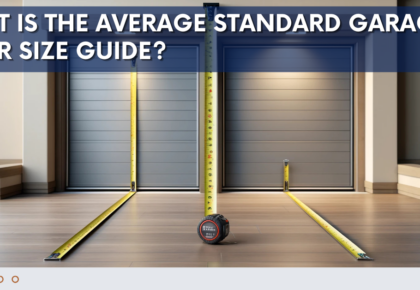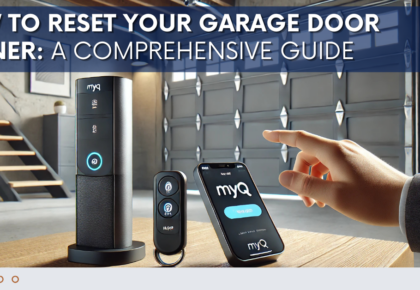As winter approaches, it’s natural to start thinking about ways to keep your home cozy and safe. Amidst all the preparations, one area that often gets overlooked is the garage. Winterizing your garage properly can keep your house warmer, reduce those pesky utility bills, and protect your belongings from the cold. Plus, a well-prepared garage can make life a whole lot easier when the snow starts to fall. Let’s dive into some practical tips to get your garage ready for winter.
1. Inspect Your Garage Door
Keep your garage door in top condition to maintain warmth and security. Check the weather stripping for wear and tear, replacing any loose or cracked sections. Clean the tracks to remove debris, and lubricate hinges, rollers, and other moving parts. Tighten all hardware, including bolts and screws. Inspect high-tension cables for damage, such as fraying or loosening. Watch and listen to the door in action for jerking or unusual noises. Taking these steps will help keep your garage door in top condition, ensuring that your garage stays warm and secure throughout the winter:
- Check weather stripping: Look for signs of wear and tear. Replace loose or cracked sections.
- Clean tracks: Remove debris to ensure smooth operation.
- Lubricate moving parts: Apply lubricant to hinges, rollers, and other moving parts.
- Tighten hardware: Ensure all bolts and screws are securely fastened.
- Inspect high-tension cables: Check for damage like fraying or loosening.
- Observe the door in action: Watch for jerking and listen for unusual noises.
2. Rotate Seasonal Items
Organizing your garage by rotating seasonal items can save you time and hassle during the colder months. Put summertime stuff such as lawn mowers, garden tools, and sports equipment in the back and snow stuff, like shovels, bags of salt, sleds, and skis that don’t have to ever be used all summer, in the front. That quick note will allow you to see exactly where everything is and locate the tools in an instant rather than sort through everything in the garage. You could also utilize storage bins or shelving with labels for all of your things. In this case, it is easy to know and see what is in the container and its location with the other major benefit of reduced time spent on a scavenger hunt done by yourself or others looking for items. Get the garage sorted at the start of winter to save yourself a lot of hassle.
3. Create a Drop Zone for Snow
All this can keep the tacking in of mud and snow into your house at a minimum; set up a drop zone near the garage entrance. You may make this a much useful addition by providing a boot tray to trap both the accompanying water and clutter that results from your often-wet shoes. Link hooks or a coat rack up to hang damp coats, mittens, scarves, and hats. This landing zone reduces cleaning and drying efforts in your living spaces, and everything is carried out in one convenient spot right upon wet gear removal. For example, you could add a bench or stool to the drop zone for added ease for taking the bins and boots off and on. You could even add a waterproof mat to help capture puddles from really wet clothes and gear. This space will not only contain the clutter from getting wet and sandy but also make finding and gathering winter gear easier when you’re running out the door.
4. Keep a Squeegee Handy
Snow and slush inside your garage, whether from the car or directly from outside, will quickly create slipperiness and probably dangerous conditions. Therefore, I made a utility squeegee for removing moisture by mounting pipe insulation to the back of a garden rake with cable ties. The very handy gadget can help you work easily to remove moisture and slush from the floor of your garage, ensuring that it is both safe and dry. A squeegee certainly works much better than a broom or a mop, for then you can easily push water out of the garage. Keep the squeegee in a convenient location so that you may use it repeatedly. A clean garage floor is normally safe from slips and falls spurred on by water and slush, thus providing a safe sanctuary throughout winter.
5. Set Up Wall Storage
Another way of maximizing space in your garage is by organizing your garage and using wall-mounted storage shelving. These racks and hooks help you avoid cluttering your floor space with stuff like sports equipment and tools. Wall storage will guarantee that everything remains ‘in its place’ and available while successfully keeping that essential garage floor free. Consider holding on to neat shelves, pegboards, or racks for specific items like skis, shovels, and bikes. This method doesn’t only keep the garage neat and presentable, it extends to protecting your equipment from getting damaged. Inconvenient methods of labeling storage canisters and cupboards should also be considered to relay awareness of where to find and properly place items for everyone within the home. Space on the wall can be put to arduous work to make your garage an organized working zone, even during the winter months.
6. Check for Temperature-Sensitive Liquids
Certain liquids, such as paint, cleaners, weed killers, and others, are likely to freeze under the prevailing conditions. Get these materials into a controlled storage area with a heat source: a basement or heated storage area where they will function properly and give normal use. If inside storage is not possible, another option is insulated storage cabinets within the garage. Clearly label those cupboards to prevent any future incidents. It is also important to inspect the containers for any leakages or breakages before storage. Inappropriate storage can cause temperature-controlled liquids to freeze, rendering them either dangerous or worthless. This also secures your investment in such products and makes them available for use whenever required.
7. Seal Cracks
Check your garage for any gaps and cracks through which cold air can gain entry or by which pests can intrude. Seal any such cracks with caulk or expanding foam to keep your garage warmer and more energy-efficient. Make sure to seal the surrounding areas of windows, doors, and the floor of the garage. Sealing these gaps will help not only to keep the garage warm, but also in avoiding entry of moisture, thus preventing further damage. It can also discourage insects from taking up roost in your garage over the winter. Be sure to select a waterproof sealant and not just any sealant available at local hardware stores. Monitor it for any signs of cracking and reseal damaged areas to maintain this first line of defense against the elements. All in all, crack sealing is cheap and one of the most realistic ways to enhance comfort and efficiency in the garage over the winter months.
8. Insulate the Walls
This can vastly improve the energy efficiency and comfort of your garage, meaning a person can work in the garage for longer hours. Proper insulation in your garage will avert entry of cold air or loss of warm air, thus you’ll need little or no additional heating. The first step, thus, of installing insulation is to identify gaps or cracks in your wall and plug for maximum efficiency in insulation. There are many insulation types from which to make your selection. These range from fiberglass, foam board, to spray foam. They all have their own perks, so select the one with perfect benefits and cost overall, relative to your needs. This has made insulated garages such a great investment, as the reduction in the bills on utilities has other added advantages, such as saving the pipes from freezing in case you live in a very cold area. The sport right next to space lets you work in a very comfortable environment. Insulate the garage door. With good insulation in place, your garage will be a versatile space for all seasons.
9. Protect Your Pipes
For a garage with water pipes, ensure that the pipes are insulated before the first freeze. Uninsulated pipes can burst, creating intentional damage on your pocket. Insulate the pipes using pipe insulation; during extremely cold temperatures, let the faucets drip the water a little bit to prevent it from freezing. Pipe insulation is relatively inexpensive and quite straightforward in conduct — it’s a very cost-effective way to protect your plumbing. Drain, winterize, and cover any outdoor spigots to ensure they are weather-proof. For increased safety in the harshest climates, add heat cables. These are some of the measures that will give you the value you deserve in ensuring that your plumbing system does not suffer from costly problems like pipe ruptures.
10. Seal Flooring
Protect your garage floor from salt and moisture damage by applying a sealant. Sealing the concrete helps prevent the corrosive effects of salt used to melt ice and snow on driveways. Regularly clean the surface to prolong the life of the sealant. For added durability, consider applying an epoxy coating, which can help prevent chipping and flaking while making the floor easier to clean. Epoxy coatings provide a tough, long-lasting surface that can withstand heavy use and harsh winter conditions. Additionally, they come in various colors and finishes, allowing you to customize the look of your garage floor. Properly sealing and maintaining your garage floor helps keep it looking great and functioning well for years to come.
11. Add Absorbent Floor Mats
Place non-slip, absorbent mats in high-traffic areas of your garage to prevent slips and falls. These catch the water for you, providing a better walking surface when wet or icy. Mats with rubber backing are particularly effective as they stay in place and provide additional traction. Position mats near entryways, work areas, and other spots where water is likely to accumulate. Regularly clean and dry the mats to maintain their effectiveness. Adding absorbent mats is a simple and affordable way to enhance safety in your garage during the winter months.
12. Stay on Top of Shoveling
Shovelling snow away from your garage door each time it starts to pile up can allow entry and exit without any problems. Don’t let snow accumulate up against the door because the weight of it will likely bend it inward. Such a problem can be pretty costly to repair. Keep a strong snow shovel or a snow blower on hand for removing snow around your garage door after every fall. Shoveling is not only for easy access but also to avoid the forming of ice and slippery conditions. On hard surfaces or where the environment is very icy, use ice melt or sand for additional traction. By staying on top of it, snow removal will help ensure functionality and safety in your garage during the winter months.
When to Call a Professional

Winterizing your garage is essential for maintaining a comfortable and efficient home, but some tasks are best left to the experts. Consider calling a professional if you encounter any of the following:
- Garage door issues: If you notice significant damage to your garage door, high-tension cables, or if the door operates erratically, it’s best to seek professional help.
- Extensive insulation needs: Adding insulation to your garage walls and ceiling can be complex. Professionals can ensure it’s done correctly and efficiently.
- Pipe insulation and heating: If your garage has water pipes or you need to install a heating system, a professional can provide safe and effective solutions.
- Floor sealing and epoxy application: Professionals can apply sealant or epoxy coatings to your garage floor, ensuring a durable and high-quality finish.
For expert assistance with any of these tasks, consider contacting MN Garage Squad. Our team can help you winterize your garage to keep it warm, efficient, and safe all season long.








